People
John Armleder on Why Art Is More Important Than Artists
The artist has concurrent shows in New York and Los Angeles.
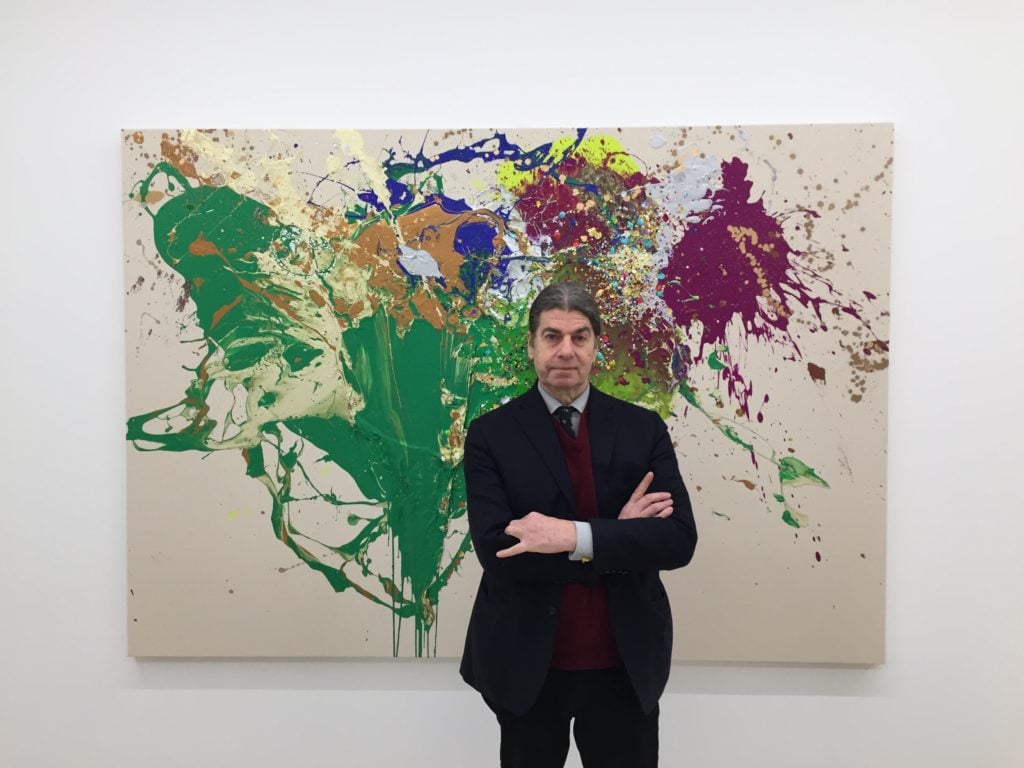
The artist has concurrent shows in New York and Los Angeles.

Henri Neuendorf

Known for an aesthetic that is distinguished by the absence of a characteristic style, John Armleder’s work spans several different mediums, ranging from painting and sculpture to design, performance, and installation, and is loosely connected by a non-hierarchical and democratic understanding of art based on the themes of appropriation, humor, and chance.
Leaning on the fluxus movement of the 1960s, Armleder was an influential member of the Geneva-based Groupe Ecart, which emerged from the eponymous Galerie Ecart performance venue in the 1970s and 1980s. He was greatly influenced by the radical American composer, artist, and philosopher John Cage, who is best known for his unorthodox conceptual songs, works that Armleder has sought to translate into the visual arts over the course of his five decade career.
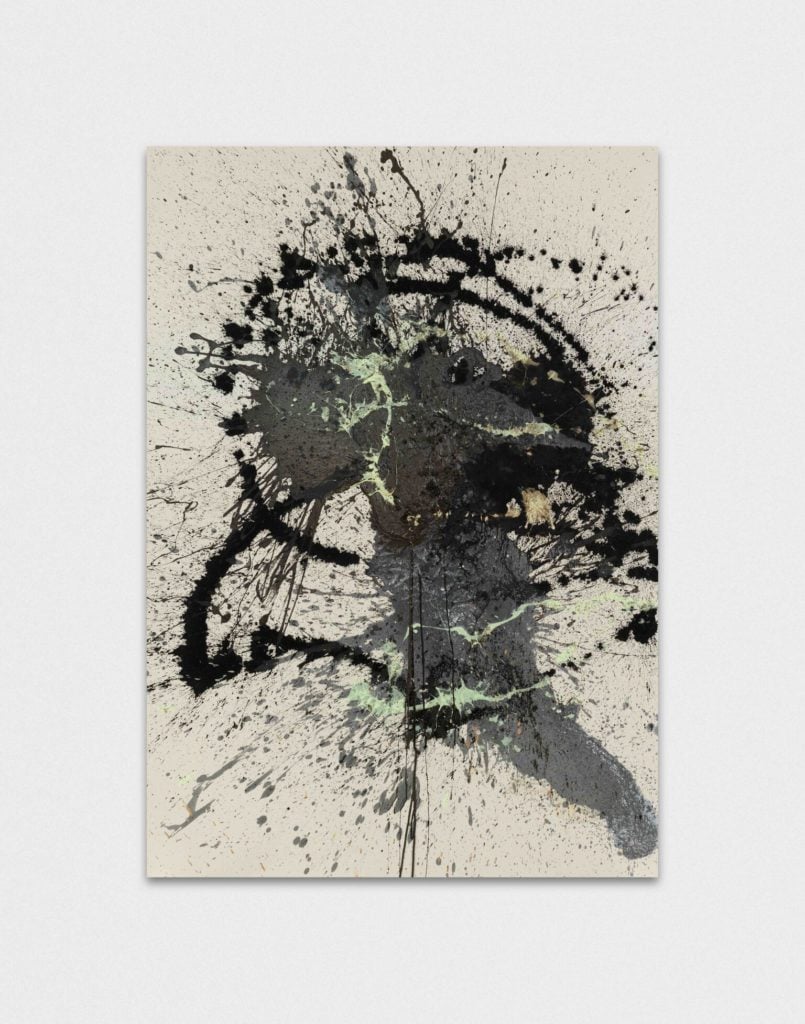
John Armleder While (2016). Photo: Annik Wetter, courtesy of the Artist and Almine Rech Gallery © John M Armleder.
Armleder has two concurrent US exhibitions on view right now at the David Kordansky Gallery in Los Angeles (through February 25), which just announced its representation of the artist, and the Almine Rech gallery in New York (through February 23). The Los Angeles show focuses on recent works, whilst the New York exhibition presents a survey of his work. The two concurrent bi-coastal shows are indicative of the recognition that Armleder is finally receiving in the US, something that he has long enjoyed in his native Europe.
Ahead of the opening of his New York exhibition, which is curated by Nicolas Trembley, the leading scholar of Armleder’s work, the 68-year-old artist sat down with artnet News at the Almine Rech Gallery on the Upper East Side to talk about his work, his beginnings, and why art is more important than artists.
You emerged from the fluxus movement of the 1960s. Can you describe your early days as an artist?
It’s difficult to describe, it seems like a century ago, but it also seems like yesterday. I had contact with the fluxus artists, but of course I’m a generation or two after those guys. I met them because of my interest for John Cage, the composer, who gave a course with some of the fluxus guys, which I followed in New York in the late 50s. That’s how I got interested in what they were doing and met some of them very early. In the late 60s I decided with friends that we’re not artists, and that we should open a gallery, which was called Ecart. We opened the gallery in ’72, and we showed quite a few of the fluxus artists in the gallery, and also performed with quite a few of the fluxus people; but we also performed the scripts of the fluxus people for many years and I still do that as a matter of fact.
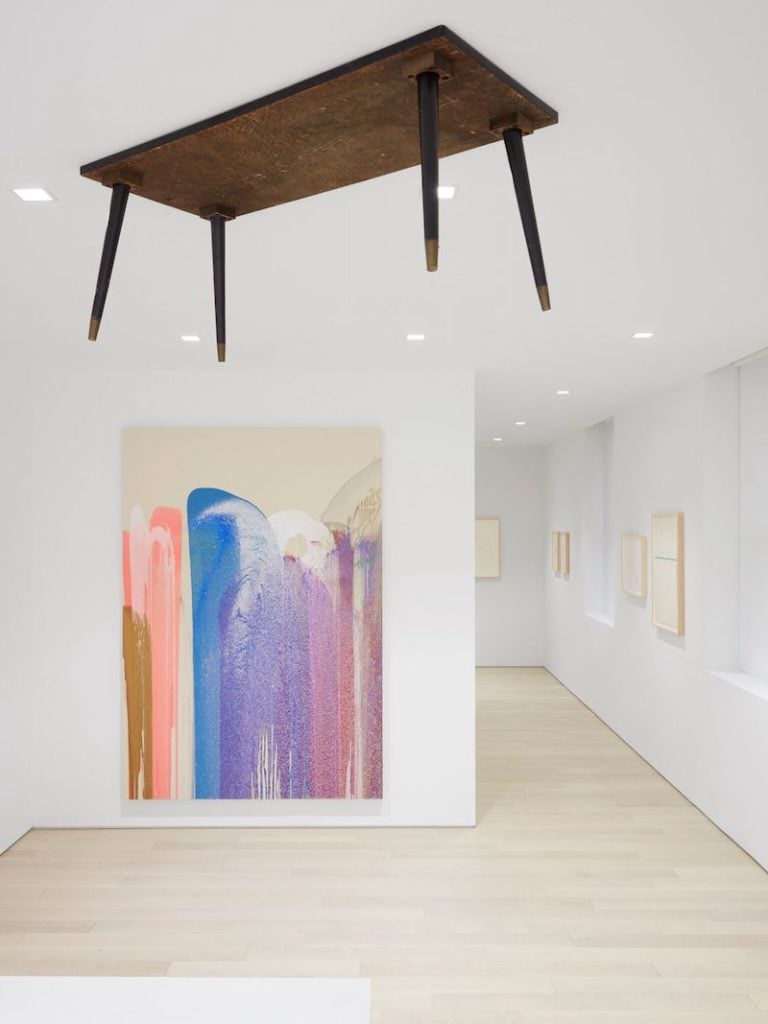
Installation view John Armleder at Almine Rech, New York. Photo: Matt Kroening, courtesy of the artist and Almine Rech Gallery © John M. Armleder.
How has your work developed since then?
The worst person to listen to about the work is the artist. I think the art should work on its own, the people who look at the works invent the works again, and the artist is just a side effect. So it’s very difficult for me to say this or that, and I don’t think it’s really my style to try to control the understanding or the focus of the work and say that it’s about this rather than about that. The one thing I could say, maybe, is that I’m an artist who comes up with new things or new forms, or new strategies for producing the work. I just go on doing different types of strategies, rather than an artist who evolves from one genre to another or from one period to another. If you want to take references of another oeuvre like mine; I’m not at at all a Picasso kind of style, who went from one type of work to another, I’m more like a Picabia kind of person, who did one different thing after another and never stopped doing different things.
You once said, “I have no genre.” So how would you define yourself as an artist?
Well, that’s already some kind of a definition isn’t it? Obviously I believe that I’m a visual artist, I’ve been interested in painting and doing three dimensional objects since I was a kid. My interest in art was also about painting, whether it’s classical art or modernist art. As a kid I was very quickly impressed by abstraction, early abstraction of the 20th century, and that has never left me, and you can see here in the show in New York. Some pieces here are direct references to that.
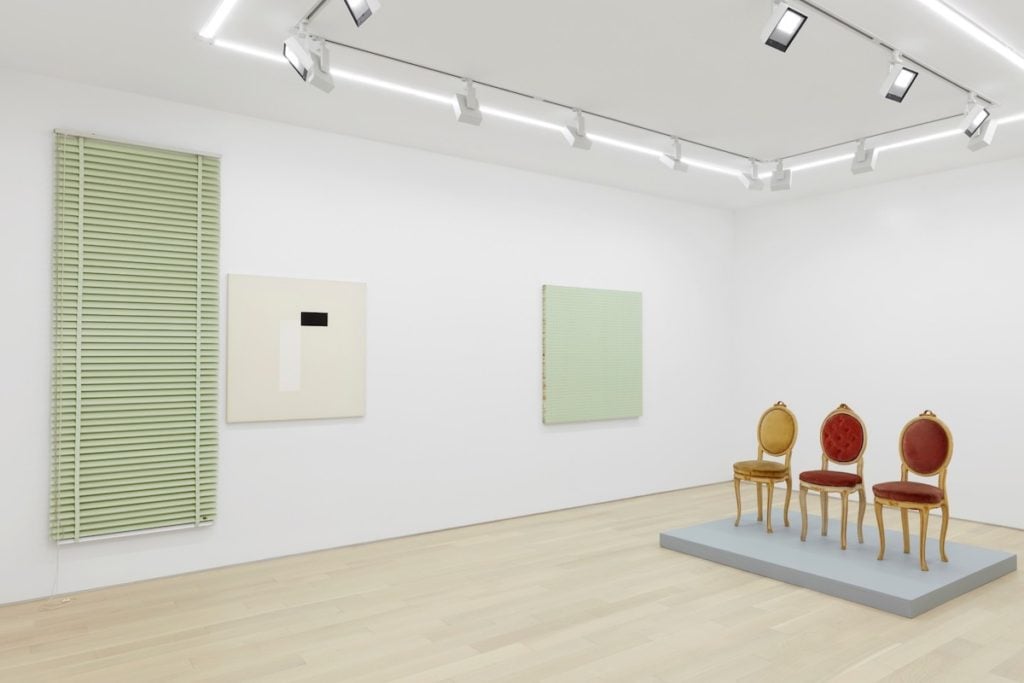
Installation view John Armleder at Almine Rech, New York. Photo: Matt Kroening, courtesy of the artist and Almine Rech Gallery © John M. Armleder.
Do you think that other artists restrict themselves by occupying a narrow niche and visual language?
No, it’s a different way. I know some artists that I respect a lot who basically follow the same strategy for doing their work all their life, like Robert Ryman doing the white paintings again and again: that’s one path; it’s just a different one than mine. But I don’t think one is more narrow than another. On the contrary, for an onlooker who follows the history of an artist, if the line is very visible [and] it’s easier to follow, there’s more hints about what the work is about, if it’s about something. In my case it’s probably much more difficult. But it’s also very enjoyable because people know you for this and for that.
Art being a product which is taken over by society, there’s fashions; for a time people thought I was only about dot paintings, or pour paintings, or furniture sculptures—they may only know one part of what I have done, and I like that a lot.
What’s the common theme that ties together the different parts of your practice? Is there a common conceptual framework that links your work?
I would hope not. Again, it’s a Duchampian way of seeing it. I think the onlooker is the one who builds the relationship, who understands how things fit together, and if they don’t fit at all and they completely escape my perception, all the better.
One always believes that the artist knows more, or understands the work he is doing better than the onlooker, or the people who take care of the work, and I think it’s not true. The artist has a very restrictive understanding of his own work because he’s so close to it, and he remembers the moments when he was making it, and the anecdotes, which are just episodes. It’s not at all a universal understanding. So what binds it all together? It’s obviously time, space—areas. And all that would be wiped out by new time, new spaces.
Like I often say, if you look at works under the spotlight today, they may have been painted at a time when people had no electric lights. It’s a totally different context. But on the other hand you could say that things have not changed that much at all.
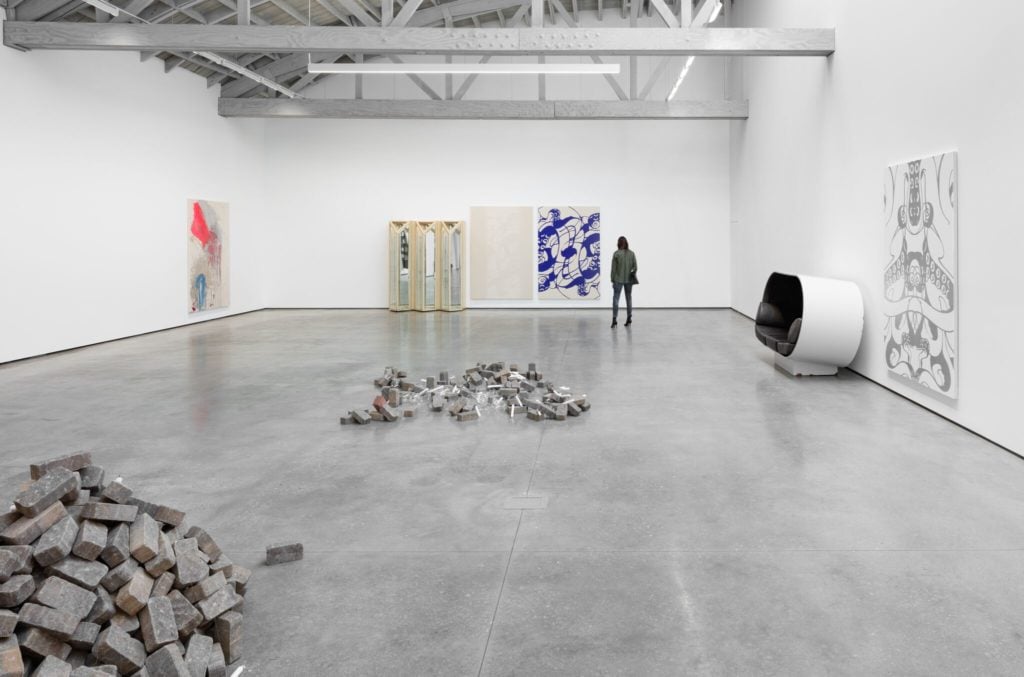
Installation view, John Armleder at David Kordansky Gallery, Los Angeles. Photo: Fredrik Nilsen, Courtesy of David Kordansky Gallery, Los Angeles, CA.
Who are some of the artists that have influenced you?
All artists have influenced me. And when I walk on the street a building or a tree influences me as much as any other artist. If you want to find closer linkages, the composer John Cage and the people around him. When I was young I was extremely impressed by the constructivists, Russian abstraction and Dutch abstraction, so that is very strongly present too.
Your New York survey exhibition looks back at work from the past, whilst the Los Angeles exhibition featuring current works looks more ahead. Which do you prefer? To look at your work from the past or to look to the future?
I tend to equalize things. I wouldn’t say that I prefer one thing to another. A show is done with other people, and they are collaborations and so the intentions are always different. New York is not Los Angeles and vice versa, and the spaces are extremely different. The show I did at Kordansky was the first one person show I did with this gallery, I had a show with Almine Rech in Brussels (in 2014), with new work, only painting, which was produced in Brussels. Circumstances influence a lot; you don’t really know what it will be about and you don’t control everything—although I’m certainly not a control freak in any way. I wouldn’t say one is more important than the other. It’s an opportunity to see the different things that I’ve done. The LA exhibition gives a different image than the show in New York, but both make sense. I’m the kind of person who wouldn’t want to impose things on people, and it was the wish of the different operations who had ideas about what they wanted to do. If they’re not comfortable with it then I’m not comfortable either.
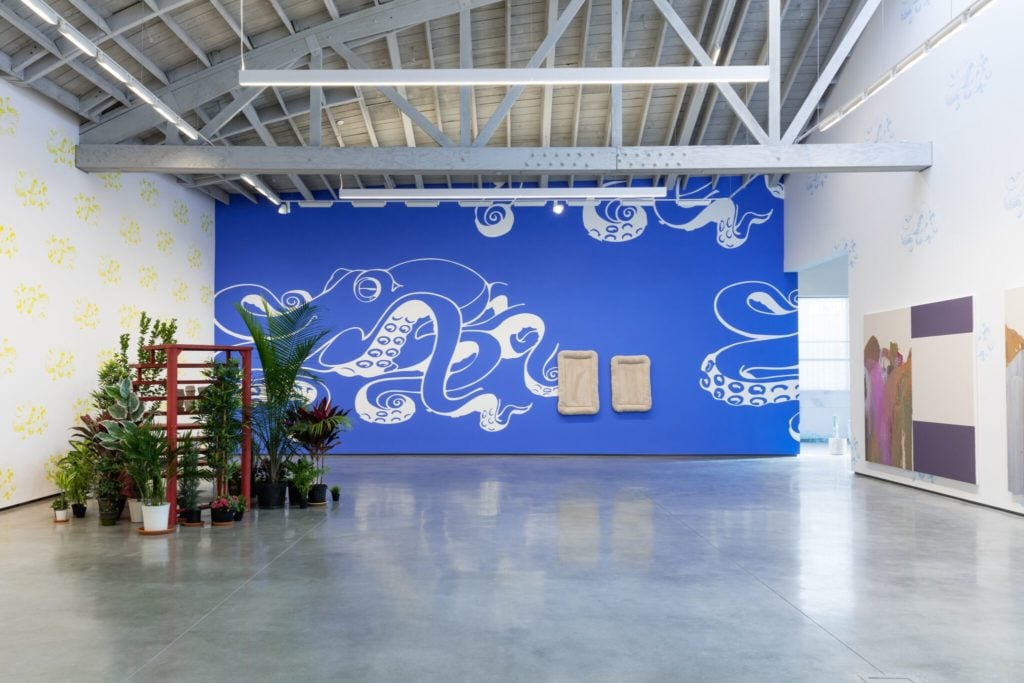
Installation view, John Armleder at David Kordansky Gallery, Los Angeles. Photo: Fredrik Nilsen, Courtesy of David Kordansky Gallery, Los Angeles, CA.
You often mention that the artist should step back and let the work speak for itself. What’s behind this reasoning?
I think we are passersby. In my case, I escaped death not so long ago, against all odds. The art, whether you want it to or not, remains, it sticks around. It’s one of the things that scared me the most when I was in my bed and was supposed to be leaving. I thought “all that mess I produced and now my kid”—I have a son—”or my friends would have to take care of it, it’s not fair.” Like if I knew better how to take care of it myself.
If you read the papers there are hundreds of things happening at the same time, and it’s only a fraction of what is really happening. As an artist you get so involved in what you’re doing that for a moment you think that it’s the only thing in the world—and it’s nothing—it’s just a hiccup. One amongst a thousand hiccups. So I would never tell people this or that about myself, or about others, or say that this is more important than something else. I’m unable to do that.
If you weren’t an artist, what would you be?
Probably an artist! When I was a kid I had a brother who was much more artistically minded than I was, although he was into writing and so on. My family was raised in a hotelier tradition, for five generations they owned a hotel. So my brother when we were fairly young said, “You want to be an artist? Okay go ahead and be an artist. I’ll take care of the hotel and you can be an artist.” He was very protective and fatherly in a way. So if I hadn’t been an artist, and if my brother was not so nice to make way for me, I’d possibly be doing what my family is doing. And when you do what your family is doing, do you know why you do it? No. You do it because you are framed in that tradition, and you have a perception about that. So maybe it would have happened that way, or perhaps totally different, who knows?
“John M. Armleder” runs through February 23, 2017 at Almine Rech, New York.
“John Armleder” runs through February 25, 2017 at David Kordansky Gallery, Los Angeles.